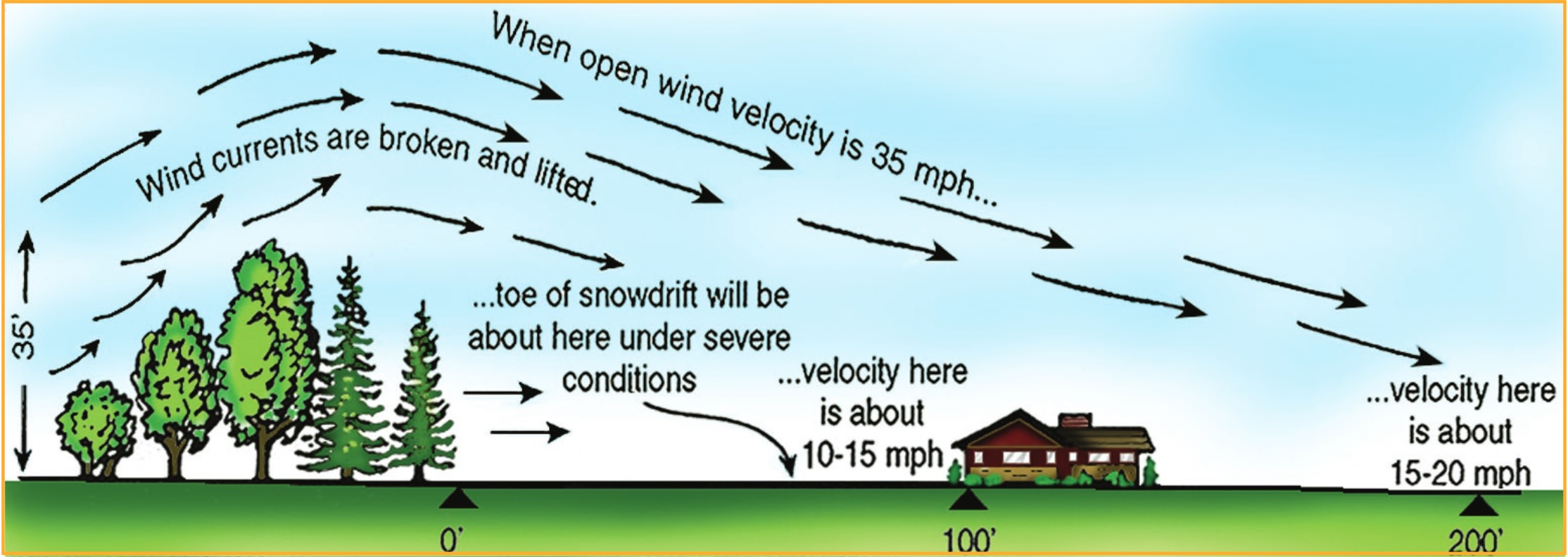 Designing a Windbreak - March 7, 2018 Jeff Schalau, Agent, Agriculture & Natural Resources University of Arizona Cooperative Extension, Yavapai County Creating a windbreak around your home or ranch will not only make the protected area more pleasant during windy periods, it will provide privacy, save on household energy consumption, and create favorable microclimate in the wind sheltered zone. The windbreak need not be created using live plant material. On small, residential properties, a well-designed, strategically placed fence may be a better choice due to space limitations. If you choose to use a living windbreak, then it is best to plan before you plant. Some important considerations include: water availability for irrigation, plant size and spacing, pests and diseases, wind direction, aesthetics, and plant species. Wind is a mass of air moving horizontally in response to changes in atmospheric pressure. As wind blows against a windbreak, air pressure builds up on the windward side (the side towards the wind), and large quantities of air move up and over the top or around the ends of the windbreak. Windbreak structure - height, density, species composition, length, orientation, and continuity - determines its effectiveness in reducing wind speed and altering the microclimate. Windbreak height is the most important factor determining the downwind area protected by a windbreak. On the windward side of a windbreak, wind speed reductions are measurable upwind for a distance of 2 to 5 times the height of the windbreak. On the leeward side (the side away from the wind), wind speed reductions occur up to 30 times the height of the windbreak downwind of the barrier. The reduction in wind velocity behind a windbreak leads to a change in the microclimate within the protected zone. Temperature and humidity levels usually increase, decreasing evaporation and plant water loss. Soil temperatures in sheltered areas are usually slightly warmer than in unsheltered areas. Taking advantage of these changes in microclimate may allow earlier planting, increased production, and can alter the microclimate to allow otherwise temperature sensitive perennial plant species to thrive in the protected area. The prevailing wind direction in our area is from the southwest. This may vary depending on adjacent time of year, topography, vegetation, and structures. Once you have lived in the area for a while, you will have noticed which direction the prevailing winds blow. It is very helpful to create a scale drawing of your property that includes structures and existing vegetation beforehand. The decision to use living plants or build a fence is largely a function of space. You may think that cost is a consideration, but this is not always true. Plants may be just as costly in the long run and you will have to wait for them to grow before they effectively reduce winds. Green plants may be more attractive, but they require maintenance and do not create and effective barrier to animals like javelina, rabbits, and deer. Design and composition of a living windbreak depends on the space available and the species and size of trees. Living windbreaks should include diverse species of trees and shrubs. Fast growing trees such as willows, cottonwoods, or elms can be removed once slower growing species reach adequate size. Plant species diversity also minimizes insect and disease problems. Arizona cypress is an excellent windbreak plant but it must have regular irrigation. Elderica pines and Leyland cypress are prone to diseases and should be avoided. Other evergreen tree species to consider are Japanese black pine, live oak, or juniper. Deciduous trees such as cottonwood and willow will not live long, but will provide quick growth. Longer-lived trees such as black locust, honey locust, mulberry, and Chinese pistache would also function well in a windbreak. Mesquites are not very tall, but will survive without irrigation after establishment. Evergreen shrubs such as Photinia and Nandina could fill in gaps between trees. Use your imagination and create the perfect combination of living and constructed features for your unique situation. Windbreaks also provide thermal protection for livestock, wildlife habitat, and firewood. I have included additional resources below. These include windbreak planning and construction resources and local plant lists to provide lists of suitable species. Follow the Backyard Gardener on Twitter – use the link on the BYG website. If you have other gardening questions, call the Master Gardener help line in the Camp Verde office at 928-554-8992 or e-mail us at verdevalleymg@gmail.com and be sure to include your name, address and phone number. Find past Backyard Gardener columns or provide feedback at the Backyard Gardener web site: http://cals.arizona.edu/yavapai/anr/hort/byg/. Photos  Diagram showing a windbreak and relationship between windbreak height and the subsequent impact on wind velocity (from: Tree Windbreaks for Farms and Homes, Purdue University Extension).
Diagram showing a windbreak and relationship between windbreak height and the subsequent impact on wind velocity (from: Tree Windbreaks for Farms and Homes, Purdue University Extension).Additional Resources Tree Windbreaks for Farms and Homes Purdue University Extension ag.purdue.edu/extension/eden/Disasters/Tree%20Windbreaks.pdf Remember to use locally adapted plant species from attached publications "Prescott Area Plant List" and "Verde Valley Plant List". Windbreak Benefits and Design Utah State University Extension digitalcommons.usu.edu/cgi/viewcontent.cgi?article=2018&context=extension_histall Remember to use locally adapted plant species from attached publications "Prescott Area Plant List" and "Verde Valley Plant List". Prescott Area Plant List University of Arizona Cooperative Extension, Yavapai County cals.arizona.edu/yavapai/publications/yavcobulletins/prescottareaplantlist.pdf Verde Valley Plant List University of Arizona Cooperative Extension, Yavapai County cals.arizona.edu/yavapai/publications/yavcobulletins/verdevalleyplantlist.pdf |